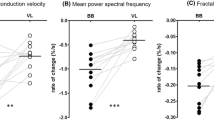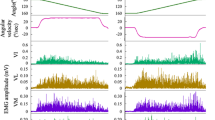Summary
Two series of experiments were performed to examine the relationship between force and change in average musle fibre conduction velocity (MFCV) during local muscle fatigue. The average MFCV was estimated using the cross-correlation method. In the first experiment this relationship was studied with surface EMG of vastus lateralis at force levels from 10 to 100% of maximal voluntary contraction (MVC) with and without occluded circulation. The product of relative force and time was held constant. At 10–20% MVC, MFCV increased slightly under the 2 conditions. Between 30–40% MVC, MFCV decreased, this decline in conduction velocity being significantly greater with occluded circulation. Above 40% MVC the decline in MFCV was larger at higher forces, but without any difference between the ischaemic and non-ischaemic conditions. In the second experiment the relationship between change in force and MFCV was studied during sustained maximal voluntary contractions of biceps brachii. MFCV declined during the first 26–39 s of the contraction, followed by an increase. Since this increase occurred when the force had dropped to 30–50% of the initial maximal force, a partial restoration of blood flow is thought to be responsible for this phenomenon. Because an increase in MFCV was noted, despite a further decline in force, this implies that at high force levels the change in MFCV during fatigue could partly be caused by mechanisms different from those accounting for the force loss. It is concluded that above 40% MVC intramuscular pressure is sufficiently high to cause ischaemia, and MFCV is found to be very sensitive to changes in intramuscular blood flow.
Similar content being viewed by others
References
Ahlborg B, Bergstrom J, Guarnieri G, Harris RC, Hultman E, Nordesjo L-O (1972) Muscle metabolism performed at constant force. J Appl Physiol 33:224–228
Andreassen S, Arendt-Nielsen L (1987) Muscle fibre conduction velocity in motor units of the human anterior tibial muscle: A new size principle parameter. J Physiol 391:561–571
Arendt-Nielsen L, Forster L, Mills KR (1984) The relationship between muscle fiber conduction velocity and force in the human vastus lateralis. J Physiol 353:6P
Barnes WS (1980) The relationship between maximum isometric strength and intramuscular circulatory occlusion. Ergonomics 23:351–357
Bigland-Ritchie B, Jones DA, Hosking GP, Edwards RHT (1979) Central and peripheral fatigue in sustained maximal voluntary contractions of human quadriceps muscle. Clin Sci Mol Med 54:609–614
Burke RE, Rudomin P, Zajac FE (1976) The effect of activation history on tension production by individual motor units. Brain Res 109:515–529
De Luca CJ (1984) Myoelectric manifestations of localized muscle fatigue. CRC Critical Reviews of Bioengineering 11:251–279
Edwards RHT, Nordesjo L-O, Koh D, Harris RC, Hultman E (1971) Isometric exercises-factors influencing endurance and fatigue. Adv Exp Med Biol 11:357–360
Edwards RHT, Hill DK, McDonnell M (1972) Myothermal and intramuscular pressure measurements during isometric contractions of the human quadriceps muscle. J Physiol:58–59P
Edwards RHT (1981) Human muscle function and fatigue. In: Porter R, Whelan J (eds) Human muscle fatigue: physiological mechanisms. Ciba foundation symposium 82. Pitman Medical, London, pp 1–18
Fitch C, Chevli R, Petrofsky JS, Kopp Js (1978) Sustained isometric contractions in muscle depleted of phosphocreatine. Life Sci 23:1285–1292
Harris RC, Hultman E, Sahlin K (1981) Glycolytic intermediates in human muscle after isometric contraction. Pflügers Arch 389:277–282
Hill AV (1948) The pressure developed in muscle during contraction. J Physiol 107:518–526
Jennische I (1982) Relation between membrane potential and lactate in gastrocnemius and soleus muscle of the cat during tourniquet ischemia and postischemic reflow. Pflügers Arch 394:329–332
Karlsson J, Funderburk CF, Essen B, Lind AR (1975) Constituents of human muscle in isometric fatigue. J Appl Physiol 38:208–211
Lindstrom L, Peterson I (1983) Power spectrum of EMG signals and its applications. In: Desmedt (ed) Progress in clinical neurophysiology, vol. 10: Computer-aided electromyography. Karger, Basel, pp 1–51
Mazella H (1954) On the pressure developed by the contraction of striated muscle and its influence of muscular contractions. Arch Int Physiol 42:334–339
Morimoto S, Masuda M (1984) Dependence of conduction velocity on spike interval during voluntary muscular contraction in human motor units. Eur J Appl Physiol 53:191–195
Naeije M, Zorn H (1982) Relation between EMG power spectrum shifts and muscle fibre action potential conduction velocity changes during local muscular fatigue in man. Eur J Appl Physiol 50:23–33
Naeije M, Zorn H (1983) Estimation of the action potential conduction velocity in human skeletal muscle using the surface EMG cross-correlation technique. Electromyogr Clin Neurophysiol 23:73–80
Petrofsky JS, Phillips CA, Sawka M, Hanpeter D, Stafford D (1981) Blood flow and metabolic products during fatiguing isometric contractions in fast and slow skeletal muscles in the cat. J Appl Physiol 50:493–502
Petrofsky JS, Hendershot DM (1984) The interrelationship between blood pressure, intramuscular pressure, and isometric endurance in fast and slow twitch skeletal muscle in cat. Eur J Appl Physiol 53:106–111
Rohmert (1960) Ermittlung von Erholungspausen für statische Arbeit des Menschen. Int Z Angew Physiol Einschl Arbeits-physiol 18:123–164
Sadoyama T, Masuda T (1987) Changes of the average muscle fiber conduction velocity during a varying force contraction. Electroenceph Clin Neurophysiol 67:495–497
Stålberg E (1966) Propagation velocity in human muscle fibers in situ. Acta Physiol Scand 287:3–112
Van Boxtel A, Schomaker LRB (1984) Influence of motor unit firing statistics on the median frequency of the EMG power spectrum. Eur J Appl Physiol 52:207–213
Zwarts MJ, Haenen HTM, Van Weerden TW (1987) The relation between the average muscle fiber conduction velocity and EMG power spectra during isometric contraction, recovery and applied ischemia. Eur J Appl Physiol 56:212–216
Zwarts MJ, Van Weerden TW, Links TP, Haenen HTM, Oosterhuis HJG (1988) The muscle fiber conduction velocity and power spectra in familial hypokalemic periodic paralysis. Muscle Nerve 11:166–173
Author information
Authors and Affiliations
Rights and permissions
About this article
Cite this article
Zwarts, M.J., Arendt-Nielsen, L. The influence of force and circulation on average muscle fibre conduction velocity during local muscle fatigue. Europ. J. Appl. Physiol. 58, 278–283 (1988). https://doi.org/10.1007/BF00417263
Accepted:
Issue Date:
DOI: https://doi.org/10.1007/BF00417263




